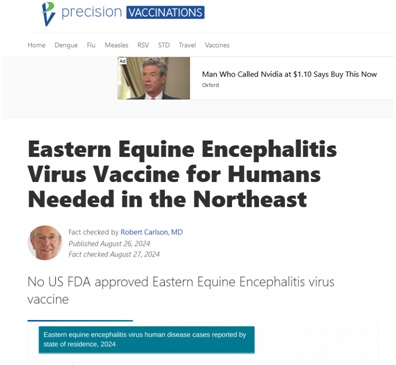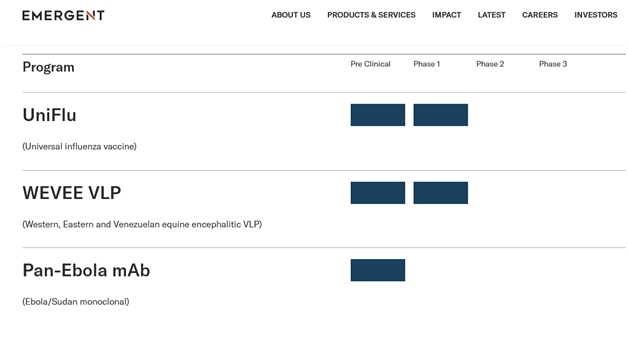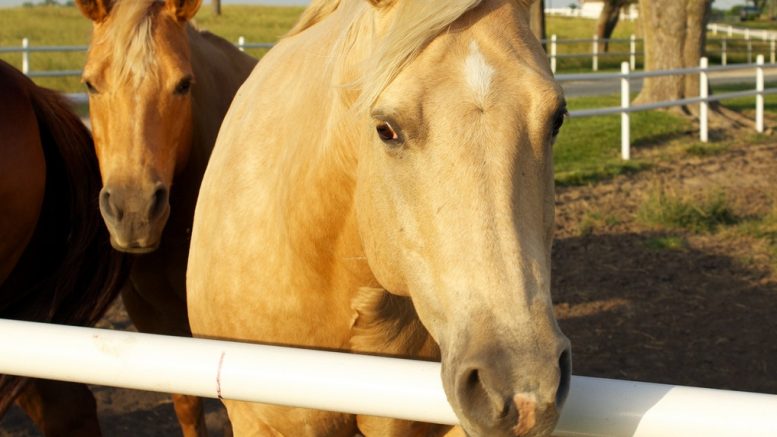Whether it is monkeypox, bird flu, RSV, Pertussis or God knows what else, the story is always fear, fear, fear. This time, however, it is horses – and humans – who are the target.
Since this summer, we have heard the drip, drip, drip of encephalitis warnings. In Florida, first reports showed that Eastern Equine Encephalitis (EEE) was “spreading rapidly” across the state during the hot, humid summer months. The media uses sentences like “the deadly horse virus is infecting more horses this year than in all of 2023.”
Hold your horses (no pun intended!)
There were only 17 cases of the disease in Florida in 2023. So far through July, there are 19. It’s hardly an epidemic, yet this is characterized as an “emerging threat.”
And then comes the magical sentence that is in every one of these articles: “The virus can also infect humans.” This is solely designed to instill fear.
What is EEE?
This form of encephalitis is a mosquito-borne virus transmitted when one of several species (Aedes, Coquillettidia and Culex) of mosquito bites a horse. Other animals are often infected and the mosquito transmits the disease (known as a vector). The virus does not spread from horse to horse, horse to human, bird to human, or human to human, for that matter. The mosquito transmits the disease, and the virus originates in birds. According to the USDA Animal and Plant Health Inspection Service (APHIS), the virus is common in birds and rodents.
Humans and horses are considered “dead end” hosts because the virus does not transmit after that point.
The virus can be lethal to both horses and humans. EEE causes severe neurological symptoms in horses, such as circling and general lack of coordination, and sadly, nine in 10 horses die from the virus. In humans, the disease is not as significant, with 96% of people never displaying symptoms. Those who do show signs usually have common viral symptoms like fever and chills. In rare cases, EEE in humans can cause brain inflammation. If the virus causes encephalitis in a person, around 30 to 45% of people die from the virus, per the CDC.
However, EEE reports in humans are rare, with only about 10 cases reported each year in the US. Typically, these cases are in the Southeast (e.g. Florida area) and along the East Coast in swampy areas. “Eastern equine encephalitis virus transmission is most common in and around freshwater hardwood swamps in the Atlantic and Gulf Coast states and the Great Lakes region,” the CDC said. The virus is also “commonly found” in Canada.
There are three forms of EEE —Eastern, Western, and Venezuelan (EEE, WEE, VEE). WEE has not been detected in the United States since the late 1990s, and VEE is found in Central and South America and occasionally in Mexico.
Human Cases
As of the end of July 2024, no human infections had been reported in the US. The town of Oxford, Massachusetts’ health board however, chose to institute an after-dark curfew to reduce the spread of the virus.
In September, the New York State Department of Health advised of a human case, and recommended all New Yorkers to take personal protective measures to avoid mosquito bites. The first one on their list is to spray yourself with a repellant that contains DEET. Seriously. They follow that statement with a statement about a confirmed case of EEE in a horse. Then they let us know that people over age 50 and under 15 are at high risk of EEE. Fear! How do they know this with so few cases?
This was the first human case since 2015 and look at the first quote issued: “EEE is a serious and fatal mosquito-borne disease with no vaccine.” Drip, drip, drip. They want your brain to register that there is no cure.
Then, in October 2024, dare I say right around the height of the election tension, the mainstream media reported a human who died, succumbing to the EEE virus. A 49-year-old man, Richard Pawulski, died of the rare brain-infecting virus. The article also made sure to mention his hard-fought five-year battle that involved seizures and paralysis, and they made sure that we all knew the list of horrible complications came from Harvard Medical School, ensuring instant compliance.
The news articles also want to make sure we hear from his family and how hard the struggle has been, and they also want us to know that Pawulski was just out doing regular yard work. No one is safe. That is the message. “Not long after discovering a mosquito bite, he complained of intense headaches and began spewing yellow bile.” Who would want that? We should all stay indoors and never do yard work again. They also make sure that we know Pawulski’s wife and daughter had to make the difficult decision to remove life support after doctors told them that Richard’s brain swelling had caused irreversible damage.
The Subtle Message
I am in no way making light of this family’s horrible plight and heartbreaking ultimate decision. The focus of this article is on the media and government and how they use subtle fear tactics disguised as reporting.
It’s also about how articles like this inevitably end…seeding the public consciousness with more fear so that when they inevitably develop another vaccine, this time for EEE, much of the population will be begging for it. They’re hoping we’ll do anything to reduce that fear and if they can make a few bucks on a vaccine that no one really needs, all the better.
The powers that be want us to know that no specific antiviral treatments exist for EEE. Care focuses on relieving the horrific symptoms. Believe me, these articles are expertly crafted to make sure all the fear buzzwords are present.
“They” want to make sure we also know that a vaccine exists for horses, but not for humans. They also want us to know that horses are seriously undervaccinated for EEE. “The vaccine is very effective at preventing disease, so most of the time when we see cases of Triple E, it’s in horses that have not received the vaccine or have been inappropriately or inadequately vaccinated.”
Make it stop. Please.
But we already determined that the disease cannot spread from horse to human. See how they instill the fear?
There is a vaccine for Japanese encephalitis, and the rabies vaccine is often used to prevent encephalitis after exposure to the rabies virus, but there is no specific vaccine for EEE. I can almost bet there will be soon, though.
The CDC also makes it sound as if there are no medications to treat EEE; they use the phrase “specifically formulated for” in case anyone fact checks them on this.

Available in ebook and paperback on Amazon and drtenpenny.com
A quick look at the literature, however, shows that acyclovir is routinely used if viral encephalitis is suspected within the first six hours of hospital admission. It seems that acyclovir has antiviral activity against herpes simplex virus and related viruses that are usually the most common causes of viral encephalitis. But since acyclovir is not specifically used for EEE, the CDC has plausible deniability.
The Bottom Line
It is also very interesting to study what they don’t say. Nowhere in any of these articles do they mention Bill Gates’ engineered mosquito experiments. We have written about mosquito tampering since 2015, in articles like this asking about simultaneous worldwide outbreaks of dengue fever, also a mosquito-borne disease. In the above reference, the NY Health Department said this: “Mosquito’s once a nuisance, are now a threat.” But notice how no one in the media or government ever dives deeper as to WHY they are a threat. Maybe Gates’ weaponization should at least be mentioned, right?
Articles like this began to appear in August 2024, demanding a human vaccine, given the rise of cases in horses. Yet no human cases had even been reported as of this time. Why do we need a jab?
In May 2022, a Phase 1 clinical trial was conducted on a trivalent vaccine developed by none other than the National Institute of Allergy and Infectious Diseases (NIAID) Vaccine Research Center. You know NIAID as Tony Fauci’s organization. The study had a favorable safety profile and a commercialization license was issued for Emergent BioSolutions in Gaithersburg, Maryland to develop the vaccine, given…wait for it…the pressing public need.
++++++++++++++++++++++++++++++++++++++++++++++++++++++++++++++++++
 Like what you’re reading on The Tenpenny Report?
Like what you’re reading on The Tenpenny Report?
Share this article with your friends. Help us grow.
Get more of Dr. Tenpenny’s voice of reason at her website.
Join our list here
Make a donation here (and thank you!)
++++++++++++++++++++++++++++++++++++++++++++++++++++++++++++++++++
Fed Up Texas Chick is a contributing writer for The Tenpenny Report. She’s a rocket scientist turned writer, having worked in the space program for many years. She is a seasoned medical writer and researcher who is fighting for medical freedom for all of us through her work.
All comments and opinions shared by our interviewees are their own and may not reflect the opinions of Dr. Tenpenny or any of *The Tenpenny Companies* programs or subsidiaries. We are neither responsible nor liable for any discrepancies in our guest authors’ articles or video recordings.


